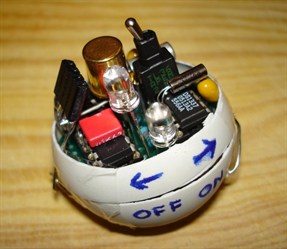Uploaded
Submitted by: kranenborg Project Website: https://www.picaxeforum.co.uk/showthread.php?9236-Picaxe-based-Satellite-PongSat-18X
Uploaded
Submitted by: kranenborg Project Website: https://www.picaxeforum.co.uk/showthread.php?9236-Picaxe-based-Satellite-PongSat-18X
My son Joost and I want to introduce our near-space PongSat-18x project.
A pongsat (www.jpaerospace.com/pongsat/index.htm) is an experiment that fits inside a pingpong ball and will be flown to the near-space area (about 30 kms high if we are lucky) free of charge by company called JPAerospace. There have been some Basic Stamp and picaxe-based pongsats before. They have recorded the temperature at the beginning of the trip in the air; at some point the temperature gets so low that an ordinary battery freezes and thus the experiment finishes, long before the highest altitude has been reached. We have registered for the planned flight of 2 May, and we decided to aim a little bit higher.
Our goals are:
Like in a real space projects there is the risk of total failure in several stages, but that's what we happily take for given ;o) The road towards it is as exciting as the final flight and data retrieval.
Central to the idea is a PICAXE-18X based flight computer that is designed for very harsh conditions: low voltage due to very low temperatures. The computer is powered by a special Lithium polymer battery that has a guaranteed functionality down to -65 degs C ! The circuit reveals that the flight computer has similarities with Rev-Eds datalogger kit, however we use different components that can operate under very low voltages (1.8V); the battery can operate at very low temperatures but the voltage drop at low temperatures is considerable as well and may be below the "standard" 2.7V limit. The computer has 7 sensors (whereof 4 analog), all served by the 18X:
All information will be stored in the special low-voltage 24AA512 EEPROM with an interval of approx. 20 secs. Development is at full speed now (I'll do mostly hardware, Joost has begun programming, we do the prototype model together).
Jurjen & Joost Kranenborg
Share